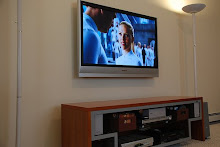Selecting a Plasma Television
By James Unterreiner
Selecting a Plasma television, or any new television for that matter, is getting more and more difficult as the features continue to increase. In this article we will cover the four main areas that make a difference in a television, mention the top brands and how to find competitive prices then finish with details on where to get additional information.
What to look for in a new television
Whether buying a Plasma TV or one of the other types on the market such as LCD or DLP there are four main areas you will want to consider no matter what type of television you buy.
Resolution Although your cable and satellite companies will most likely broadcast HDTV in 720P or 1080i because of bandwidth limitation, 1080P (1920 X 1080 lines) is the future. The new Blu Ray and HD DVD players along with the Playstation 3 all support 1080P. Therefore if your television watching is mostly cable or satellite feeds, look for 720P or 1080i, which should do the trick for now. But if you are looking toward the future and want to get the most from your new movie players or video games look for a 1080P television.
Size-Although the size of Plasma Televisions range from 42 to over a 100, the popular sizes are 42 and 50. If you are looking for something smaller then 42, consider a LCD TV. They have picture qualities similar to Plasma along with a thin flat design that can hang on your wall.
Aspect Ratio- The aspect ratio is the ratio of width to the height of your screen. Although there are several other sizes available by far the most popular are 4:3 (standard television) and 16:9 (widescreen television). Movie and television content is moving to HDTV, which is in the 16:9 format, so we suggest purchasing a 16:9 based television. When you watch video content that is not in the same format as your screen you will see black lines either on the sides or on the top and bottom. Some televisions provide the ability to compensate this by stretching the image to fit the screen, but this results in things looking wider (fatter) or taller (skinner) then they really are. Better televisions lesson the stretching but soon most broadcasts will be the 16:9 format so if you buy a widescreen (16:9) TV you will not need to worry about it.
Connections-HDMI is the video connection of the immediate future, however DVI and Component are also reasonable choices. Keep in mind your big screen television may not have speakers therefore you may want to purchase a surround sound system. Also keep in mind the connections your existing components have and make sure the television has the ability to connect with your existing components.
Brands, Prices and Additional Information
Popular Plasma Television brands are currently Panasonic, Pioneer and Samsung. The best values can be found in the more popular sizes, currently 42 to 50, due to the competition between manufactures. Like all technologies, Plasma televisions do have limitations. For information on the limitations, price comparisons, connection details, understanding the technology articles and comparisons between plasma technology and DLP TV or LCD TV technologies, see our Plasma Television Guide.
James Unterreiner is the editor and publisher of Home Theater, Automation and Electronics - Everything you need to know to create an exciting Home Theater that exceeds your expectations, excites your friends and neighbors and stays within your budget.
Article Source: http://EzineArticles.com/?expert=JamesUnterreiner
http://EzineArticles.com/?Selecting-a-Plasma-Television&id=409105

0 comments:
Post a Comment